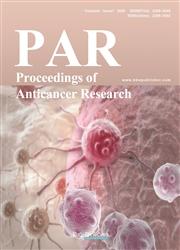The Level of Circulating Tumor Cells in Patients with Non-Small Cell Lung Cancer and Its Relationship with Tumor Markers
引用次数: 0
Abstract
Objective: To explore the level of circulating tumor cells in patients with non-small cell lung cancer and its relationship with tumor markers. Methods: Fifty patients with NSCLC admitted to a hospital from March 2019 to February 2022 were retrospectively selected as the research subjects; their clinical data were sorted out and analyzed. All patients were examined for CTCs. According to their levels, the patients were divided into a positive group (30 cases, ? 4%) and a negative group (20 cases, < 4%). The positive rate of peripheral CTCs in patients with different gender, age, and pathological types of NSCLC, the positive rate of peripheral CTCs in patients with different staging of NSCLC, and the relationship between serum CEA, CA125, CYFRA21-1, and peripheral CTCs were analyzed and observed. Results: There was no significant difference in gender, age, and pathological type between the positive group and the negative group. There was also no significant difference in the T staging, N staging, and M staging between the positive group and the negative group. However, there was significant difference in the clinical staging of the positive group and the negative group. The CEA, CA125, and CYFRA21-1 of the positive group were 7.45 ± 1.26, 38.56 ± 4.12, and 5.01 ± 1.36, respectively, whereas those of the negative group were 5.12 ± 1.22, 32.69 ± 4.01, and 3.87 ± 1.25, respectively. The comparison between the two groups was statistically significant. Conclusion: CTCs provide the possibility of detecting cancer before the use of imaging methods, guide treatment in combination with other tumor markers, monitor postoperative treatment, and predict patients’ outcome.非小细胞肺癌患者循环肿瘤细胞水平及其与肿瘤标志物的关系
目的:探讨癌症患者循环肿瘤细胞水平及其与肿瘤标志物的关系。方法:回顾性选择2019年3月至2022年2月收治的50例NSCLC患者作为研究对象;对其临床资料进行整理和分析。所有患者均接受CTC检查。根据其水平,患者被分为阳性组(30例,?4%)和阴性组(20例,<4%)。分析观察不同性别、年龄、病理类型NSCLC患者外周CTC的阳性率,不同分期NSCLC患者的外周CTCs阳性率,以及血清CEA、CA125、CYFRA21-1与外周CTCs的关系。结果:阳性组与阴性组在性别、年龄、病理类型等方面无显著差异。阳性组和阴性组的T分期、N分期和M分期也没有显著差异。然而,阳性组和阴性组的临床分期有显著差异。阳性组CEA、CA125和CYFRA21-1分别为7.45±1.26、38.56±4.12和5.01±1.36,而阴性组分别为5.12±1.22、32.69±4.01和3.87±1.25。两组之间的比较具有统计学意义。结论:CTCs为癌症的影像学检查提供了可能,并结合其他肿瘤标志物指导治疗,监测术后治疗,预测患者的预后。
本文章由计算机程序翻译,如有差异,请以英文原文为准。
求助全文
约1分钟内获得全文
求助全文

 求助内容:
求助内容: 应助结果提醒方式:
应助结果提醒方式:


